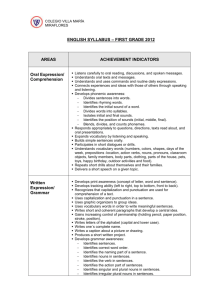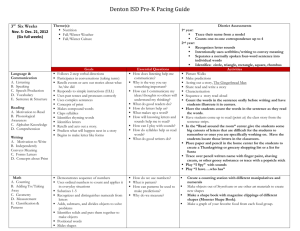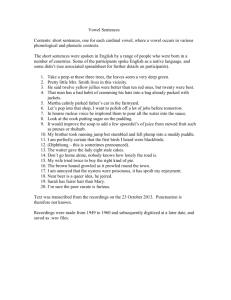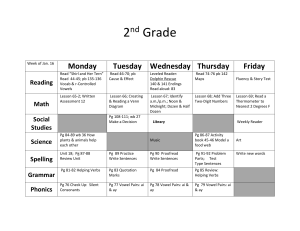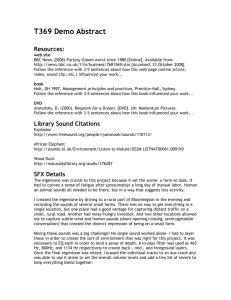miraflores
advertisement
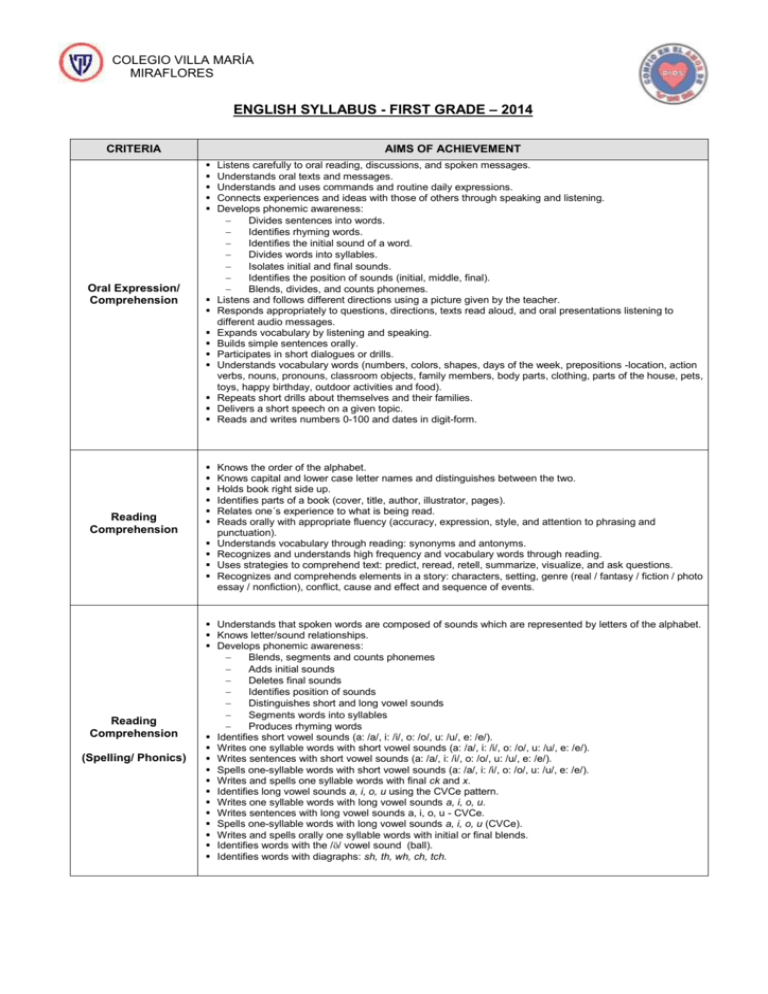
COLEGIO VILLA MARÍA MIRAFLORES ENGLISH SYLLABUS - FIRST GRADE – 2014 CRITERIA AIMS OF ACHIEVEMENT Oral Expression/ Comprehension Reading Comprehension Reading Comprehension (Spelling/ Phonics) Listens carefully to oral reading, discussions, and spoken messages. Understands oral texts and messages. Understands and uses commands and routine daily expressions. Connects experiences and ideas with those of others through speaking and listening. Develops phonemic awareness: Divides sentences into words. Identifies rhyming words. Identifies the initial sound of a word. Divides words into syllables. Isolates initial and final sounds. Identifies the position of sounds (initial, middle, final). Blends, divides, and counts phonemes. Listens and follows different directions using a picture given by the teacher. Responds appropriately to questions, directions, texts read aloud, and oral presentations listening to different audio messages. Expands vocabulary by listening and speaking. Builds simple sentences orally. Participates in short dialogues or drills. Understands vocabulary words (numbers, colors, shapes, days of the week, prepositions -location, action verbs, nouns, pronouns, classroom objects, family members, body parts, clothing, parts of the house, pets, toys, happy birthday, outdoor activities and food). Repeats short drills about themselves and their families. Delivers a short speech on a given topic. Reads and writes numbers 0-100 and dates in digit-form. Knows the order of the alphabet. Knows capital and lower case letter names and distinguishes between the two. Holds book right side up. Identifies parts of a book (cover, title, author, illustrator, pages). Relates one´s experience to what is being read. Reads orally with appropriate fluency (accuracy, expression, style, and attention to phrasing and punctuation). Understands vocabulary through reading: synonyms and antonyms. Recognizes and understands high frequency and vocabulary words through reading. Uses strategies to comprehend text: predict, reread, retell, summarize, visualize, and ask questions. Recognizes and comprehends elements in a story: characters, setting, genre (real / fantasy / fiction / photo essay / nonfiction), conflict, cause and effect and sequence of events. Understands that spoken words are composed of sounds which are represented by letters of the alphabet. Knows letter/sound relationships. Develops phonemic awareness: Blends, segments and counts phonemes Adds initial sounds Deletes final sounds Identifies position of sounds Distinguishes short and long vowel sounds Segments words into syllables Produces rhyming words Identifies short vowel sounds (a: /a/, i: /i/, o: /o/, u: /u/, e: /e/). Writes one syllable words with short vowel sounds (a: /a/, i: /i/, o: /o/, u: /u/, e: /e/). Writes sentences with short vowel sounds (a: /a/, i: /i/, o: /o/, u: /u/, e: /e/). Spells one-syllable words with short vowel sounds (a: /a/, i: /i/, o: /o/, u: /u/, e: /e/). Writes and spells one syllable words with final ck and x. Identifies long vowel sounds a, i, o, u using the CVCe pattern. Writes one syllable words with long vowel sounds a, i, o, u. Writes sentences with long vowel sounds a, i, o, u - CVCe. Spells one-syllable words with long vowel sounds a, i, o, u (CVCe). Writes and spells orally one syllable words with initial or final blends. Identifies words with the /ö/ vowel sound (ball). Identifies words with diagraphs: sh, th, wh, ch, tch. Written Expression Grammar Develops print awareness (concept of letter, word and sentence). Develops tracking ability (left to right, top to bottom, front to back). Recognizes that capitalization and punctuation are used for comprehension of a text. Uses capitalization and punctuation in a sentence. Uses graphic organizers to group ideas. Uses vocabulary words in order to write meaningful sentences. Writes short and coherent paragraphs that develop a central idea. Gains increasing control of penmanship (holding pencil, paper position, stroke, position). Writes letters of the alphabet (capital and lower case). Writes one´s complete name. Uses a rubric as a guide when writing. Describes a picture or drawing in sentence form. Produces a short written project. Uses the five-step writing process. Identifies the characteristics of and writes couplets. Develops grammar awareness: Identifies sentences. Identifies correct word order. Identifies the naming part of a sentence. Identifies nouns in sentences. Identifies the verb in sentences. Identifies the action part of sentences. Identifies singular and plural nouns in sentences. Identifies irregular plural nouns in sentences. Identifies pronouns in sentences. Identifies the verb “to be” in sentences. Identifies the verb has/have in sentences. Blends, reads, and sorts words with the inflected s-ending in the simple present tense. Blends, reads, and sorts words with the inflected ing-ending in the present continuous tense. Blends, reads and sorts contractions: 'm,'s, 're, n't, 'll.
